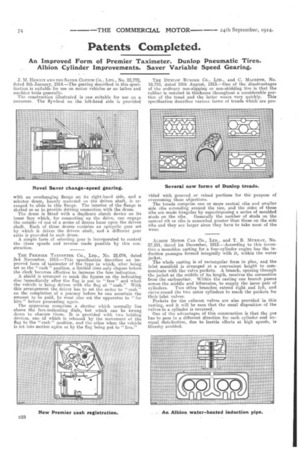Patents Completed.
Page 20

If you've noticed an error in this article please click here to report it so we can fix it.
An Improved Form of Premier Taximeter. Dunlop Pneumatic Tires. Albion Cylinder Improvements. Saver Variable Speed Gearing.
J. M. HEWITT AND THE SAVER CLUTCH CO., LTD., ND. 23,772, dated 8th January-, 1914.—The gearing described in this specification is suitable for use on motor vehicles or on lathes and machine tools generally.
The construction illustrated is one suitable for use on a motorcar. The flywheel on the left-hand side is provided with an overhanging flange on its right-hand side, and a selector drum, loosely mounted on the driven shaft, is arranged to slide in this flange. The interior of the flange is slotted so as to provide driving connection with the drum. The drum is fitted with a duplicate clutch device on its inner face which, for connecting up the drive, can engage the outside of one of a series of drums loose upon the driven shaft. Each of these drums contains an epicyclic gear set by which it drives the driven shaft, and a different gear ratio is provided in each drum.
A simple form of selecting gear is incorporated to control the three speeds and reverse made possible by this construction.
TEE PREAIER TAXIMETER CO., LTD., No. 25,074, dated 3rd November, 1913.—This specification describes an improved form of taximeter of the type in which, after being set to the "cash" position: a limited time only elapses before the clock becomes effective to increase the fare indication.
A shield is arranged to mask the figures on the indicating disc immediately after the flag is put to "free" and when the vehicle is being driven with the flag at " cash." With this arrangement the driver has to set the meter to "cash " on the completion of a journey before he can ascertain the amount to be paid, he must also set the apparatus to "for hire" before proceeding again. The apparatus comprises a shutter which normally lies above the fare-indicating dials, but which can be swung down to obscure them. It is provided with two holding devices, one of which is released by the movement of the flag to the "cash" position, and the other when the vehicle is set into motion again or by the flag being put to "free."
TEE DUNLOP RUBBER CO., LTD., and C. ridacEETE, No. 18,710, dated 18th August, 1913.—One of the disadvantages of the ordinary non-slipping or non-skidding tire is that the rubber is reduced in thickness throughout a considerable portion of the tread and the latter wears very quickly. This specification describes various forms of treads which are pro
vided with grooved or raised portions for the purpose of overcoming these objections. The treads comprise one or more central ribs and smaller side ribs extending around the tire, and the sides of these ribs are made irregular by superimposing a series of moulded studs on the ribs. Generally the number of studs on the central rib or ribs is somewhat greater than those on the side ribs and they are larger since they have to take most of the wear.
ALBION MOTOR CAR CO., LTD., and T. B. MURRAY, No. 27,591, dated 1st December, 1913.--According to this invention a monobloc casting for a four-cylinder engine has the induction passages formed integrally with it, within the water jacket.
The whole casting is of rectangular form in plan, and the inlet manifold is arranged at a convenient height to communicate with the valve pockets. A branch, opening through the jacket at the middle of its length, receives the connection from the carburetter. Within the casting one branch passes across the middle and bifurcates, to supply the inner pair of cylinders. Two other branches extend right and left, and curve round the two outer cylinders to reach the pockets for their inlet valves.
Pockets for the exhaust valves are also provided in this casting, and it will be seen that the usual disposition of the valves in a cylinder is reversed. One of the advantages of this construction is that the gas has to pass in a different direction for each cylinder and unequal distribution, due to inertia effects at high speeds, is thereby avoided.




















